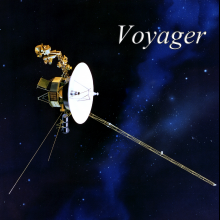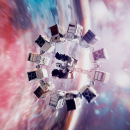Voyager
Subido por SG-Bass el 13/10/2013
Licencia Copyright
Descripción
Inspirado en las señales recibidas de las sondas Voyager 1 y 2.
Letra
The Voyager 1 and 2 space probes explored the Solar System since the end of the 70’s. They sent pictures of Jupiter in 1979, Saturn in 1981, Uranus in 1986 and Neptune in 1989. Both probes had similar transmitting systems. The downlink data transmission was done at 8.466 GHz with a radiated power of 21.3 W and as antenna they used a parabolic reflector with a diameter of 3.4 m and a gain of 48.13 dB.
The terrestrial segment of the radiocommunication link was based on NASA’s Deep Space Network (DSN) that consists on three large reflectors in Spain, Australia and California. These three reflectors are 120º of longitude apart, so at any given time one of them can be pointed towards the probe. In the year 1979 when the images from Jupiter were received the diameter of those reflectors were 64 m with a gain of 72.2 dB at the probes transmission frequency.
a) The distance from Jupiter to the Earth is 6.8 108 km. What was the S/N ratio if the bandwidth was 115 kHz and the system noise temperature 28.5 K ?
b) What pointing accuracy must be required to the DSN antenna so the S/N does not degrade more than 3 dB?
In the 10 years that elapsed from the reception of the images from Jupiter to the reception of the images from Neptune the DSN system was upgraded. Specifically the diameter of the reflectors was enlarged to 70 m, so the resulting gain of the antenna was 74.3 dB. The system noise temperature was reduced to 25.5 K and the transmission bandwidth was reduced to 21.6 kHz.
c) The distance from Neptune to the Earth is 4.32 109 km. What would have been the S/N in the transmission of the images from Neptune if the system would not have been upgraded?
d) What was the gain of the S/N in the reception of the images from Neptune due to each one of these factors: increment in gain, bandwidth reduction, system noise reduction?
Due to the coding scheme that was used only a S/N ratio of 3 dB was required to have a BER smaller than 5 10-3. In order to assure a good reception of the images from Neptune it was necessary to combine the signal received by the DSN antenna, with the received signal from two 34 m diameter antenna and the 27 25-meter diameter antennas of the Very Large Array (VLA) radiotelscope of New Mexico. This combination offered an additional 5 dB improvement in S/N ratio.
The terrestrial segment of the radiocommunication link was based on NASA’s Deep Space Network (DSN) that consists on three large reflectors in Spain, Australia and California. These three reflectors are 120º of longitude apart, so at any given time one of them can be pointed towards the probe. In the year 1979 when the images from Jupiter were received the diameter of those reflectors were 64 m with a gain of 72.2 dB at the probes transmission frequency.
a) The distance from Jupiter to the Earth is 6.8 108 km. What was the S/N ratio if the bandwidth was 115 kHz and the system noise temperature 28.5 K ?
b) What pointing accuracy must be required to the DSN antenna so the S/N does not degrade more than 3 dB?
In the 10 years that elapsed from the reception of the images from Jupiter to the reception of the images from Neptune the DSN system was upgraded. Specifically the diameter of the reflectors was enlarged to 70 m, so the resulting gain of the antenna was 74.3 dB. The system noise temperature was reduced to 25.5 K and the transmission bandwidth was reduced to 21.6 kHz.
c) The distance from Neptune to the Earth is 4.32 109 km. What would have been the S/N in the transmission of the images from Neptune if the system would not have been upgraded?
d) What was the gain of the S/N in the reception of the images from Neptune due to each one of these factors: increment in gain, bandwidth reduction, system noise reduction?
Due to the coding scheme that was used only a S/N ratio of 3 dB was required to have a BER smaller than 5 10-3. In order to assure a good reception of the images from Neptune it was necessary to combine the signal received by the DSN antenna, with the received signal from two 34 m diameter antenna and the 27 25-meter diameter antennas of the Very Large Array (VLA) radiotelscope of New Mexico. This combination offered an additional 5 dB improvement in S/N ratio.
Descargable
Sí (loguéate o regístrate para descargar)







